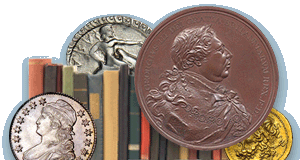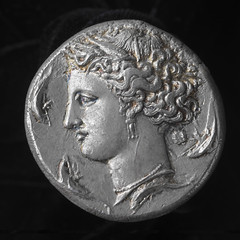
PREV ARTICLE
NEXT ARTICLE
FULL ISSUE
PREV FULL ISSUE
THE SMITHSONIAN'S ANCIENT GREEK AND ROMAN COINSNational Numismatic Collection Curator Ellen Feingold announced the recent completion of a assessment of the Smithsonian's ancient Greek and Roman coin holdings -Editor
The Smithsonian’s National Numismatic Collection holds approximately 26,900 Greek and Roman coins and has good representation in all areas of ancient coinage. A group of scholars recently carried out an assessment that revealed some exceptional strengths of the collection, including world-class holdings of eastern Roman provincial and civic coin issues and a number of older hoards. A narrative overview of the assessment and listing of the coins is now available on the National Numismatic Collection’s website (http://americanhistory.si.edu/national-numismatic-collection/collection). Anyone with an interest in consulting any of these coins is invited to email Ellen Feingold, curator of the National Numismatic Collection, at FeingoldE@si.edu or Jennifer Gloede, Outreach and Collections Specialist, at GloedeJ@si.edu. Here is an excerpt from the assessment's overview narrative. -Editor
The collection has a good representation of all areas of ancient coinage, totalling 26,972 pieces (far more than the 12,000–13,000 pieces it was estimated to contain prior to this assessment) Although there are many pieces of Greek gold and silver, the collection is mostly of bronze coinage. The silver especially includes a number of forgeries and copies, often electrotypes, and it may be that more such pieces would be identified after a more careful study than was possible in this exercise. Non-genuine coins of one type or another include some ancient forgeries, as well as a range of early modern and modern copies, both those that were made with the intent to deceive and others made to serve as inexpensive copies of rare or remarkable pieces. This subset of the collection is perhaps interesting in its own right, and a more careful reckoning of the types and number of forgeries and copies would be worthwhile. The Greek coinage, which includes pieces from throughout the ancient Mediterranean world, displayed several areas of considerable strength. One well-represented region was southern Italy and Sicily; in the collection of pieces from these areas were many silver tetradrachms of Messana (famous for being the site of the first major conflict between Rome and Carthage at the start of the First Punic War), and coins of Syracuse, possibly from a hoard. An unexpected strength was the very extensive holdings of Greek city coinage, especially of the Roman imperial period, from the north-eastern Balkans, for example mints in Moesia and Thrace (numbering approximately 2,000 specimens). In the latter region, the mint of Hadrianopolis was represented by 61 bronze Roman imperial coins, possibly from a hoard. Many silver coins of Dyrrhachium (Durres in present-day Albania) may also constitute the remains of an ancient hoard. Among the strengths of the Roman collection is a good series of gold aurei: nearly every emperor, even those who ruled quite briefly and whose coins are thus very rare, is represented by at least one or two specimens. The Roman material also includes at least two hoard groups: the earlier is a group of sestertii of the 3rd century AD, down to Gallienus in the 260s (with coins of the emperors Severus Alexander, Gordian III, and Philip present in large numbers); the second is the ‘Rosen Hoard’ (currently being prepared for publication by Cloke) of nearly 600 bronze nummi of the tetrarchic period, with an end date circa AD 312/313. Each of these large groups likely merits further study and publication. There is a reasonable collection of Roman Republican coins, mostly silver, which are arranged following Sydenham’s catalogue, The Coinage of the Roman Republic. Parallel to the representative sample of imperial Roman issues are a vast quantity of provincial issues of the Greek east, housed in the Greek coin cabinets (see the above discussion of Greek coins of the Balkans and modern Turkey). Also notable among these, in addition to the aforementioned regional groups, is a sizeable lot of bronze and debased silver issues from Egypt, which span the entirety of the principate and constitute a significant subset of Roman provincial coinage in the collection. To read the complete narrative, see: For more information on the National Numismatic Collection, or to search the catalog, see: Wayne Homren, Editor The Numismatic Bibliomania Society is a non-profit organization promoting numismatic literature. See our web site at coinbooks.org. To submit items for publication in The E-Sylum, write to the Editor at this address: whomren@gmail.com To subscribe go to: https://my.binhost.com/lists/listinfo/esylum All Rights Reserved. NBS Home Page Contact the NBS webmaster 
|
